

The Conquests expansion adds four new great wonders and one new small wonder, as well as many more which only exist in the nine scenarios. Most of these new wonders are concentrated in the Ancient Age, and many of them become obsolete over time. There were also some minor changes to old wonders which I will include here as well.
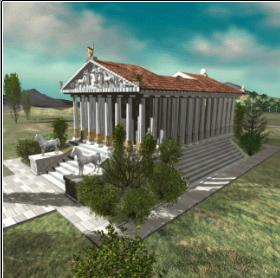 |
<--- Temple of Artemis |
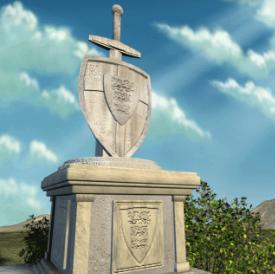 |
Temple of Artemis: This wonder is enabled by the tech Polytheism and was the subject of much debate during the beta test. It places a temple in every city on the same continent it is built, much like how the Pyramids provides free granaries and Sun Tzu free barracks. These temples do provide culture, but they are not permanent; the wonder is obsoleted by the discovery of Education, just like the Great Library. The wonder costs 500 shields, making it the most expensive Ancient Age wonder, has the Religious characteristic, and provides good culture itself at 4 culture/turn. It also has the ability to become a "tourist attraction", a feature new to Conquests. This basically means that the city which has the wonder will produce extra commerce over time as the wonder becomes more ancient; I think it increases after every 100 turns. Pretty much every single Ancient and Medieval wonder has the ability to become a tourist attraction, so I won't list them all here. Building the Temple of Artemis usually has the effect of ballooning the culture of that civ, and it is also a very desirable wonder to capture. If you're a warmonger, you can ignore culture completely and just capture the wonder for free expansions. Also note that you can skip Education if you have the wonder and just beeline down the bottom of the tree to Military Tradition while still making use of its effects... Certainly a strong wonder, and one sure to be heavily fought over for control of its free cultural buildings.
Statue of Zeus: Possibly an even more controversial wonder. The Statue of Zeus produces an Ancient Cavalry unit (3/2/2 with +1hp) every 5 turns until it is obsoleted by the discovery of Metallurgy. Since this wonder can be built as soon as Mathematics is discovered, that has the potential to be a very long time. And Ancient Cavalry are definitely strong units; who wouldn't want a free Gallic Swordsman every 5 turns who also has a bonus hit point? This is where the controversy comes in, however: the Stautue of Zeus requires the luxury resource ivory to be built. No ivory, no wonder. And since it only costs 200 shields (definitely too cheap in my opinion), this wonder can give an immense advantage to the civ which by dumb luck just happened to start next to the world's supply of ivory. Some people will probably like this wonder and some won't; I'm somewhat indifferent to it at the moment, but I'm not a fan of the random luck element involved with the resource. Certainly it makes ivory a much more desired item in the Ancient Age! Also keep in mind that this wonder's value is heavily tied to map size; it's not all that great on a huge map, but on a tiny map look out.
Mausoleum of Mausollos: This is a wonder intended not to have drastic effects, which is almost nice for a change compared to some of the other new ones. The Mausoleum is enabled by Philosophy, costs 200 shields, and adds 3 happy faces in the city in which it is built. Unlike the previous two wonders, it never expires. The Mausoleum isn't ever going to break the game open for you, but it's a nice little wonder to stick in your capital city for happiness purposes and extra culture - as well as its role as a tourist attraction. Its characteristics are Scientific and Seafaring, so you may be able to use it to trigger a golden age as well. A nice little addition to the main game.
Knights Templar: The only new wonder added to the Middle Ages, the Knights Templar also produces free military units which cannot be built any other way. It can be constructed upon the discovery of Chivalry, and produces a Crusader unit (5/3/1) every 5 turns until being obsoleted by Steam Power. At a cost of 300 shields, this is a very cheap wonder for the Middle Ages, and since the AI frequently passes over Chivalry, there is an excellent chance that human players can built this wonder themselves if desired. With that in mind though, it should be remembered that there are many other, probably better wonders also in play at this time on the tech tree, so which ones to shoot for are the player's choice. I also don't think that the Crusader is nearly as good of a unit as the Ancient Cavalry, so factor that in as well. Like the Statue of Zeus, the Knights Templar will be of more value on smaller map sizes. Finally, it should also be noted that the wonder is Militaristic and Religious and does NOT become a tourist attraction with age.
Secret Police Headquarters: This is a new small wonder which only functions under Communism. Enabled by Espionage, it acts as a second Forbidden Palace for corruption-fighting purposes. It also costs the same price at 200 shields. With this small wonder and the increase in optimal city count, Communism has been greatly improved in the expansion and is the best wartime government for the Industrial and Modern Ages. Communism certainly looks better than Fascism in this author's opinion.
Great Wall: Not a new wonder of course, but the function of this wonder has changed. It still doubles combat bonuses against barbarians, but instead of doubling the strength of city walls, it now adds free walls in all cities on the same continent. The price has been increased to 300 shields to reflect this, but this is now a very strong wonder indeed. Who wouldn't want to increase the defensive power of every single unit in their cities by 50%? If the AI builds this wonder, you may want to consider targeting a different civ for attack. Still obsoletes with Metallurgy though, so at least the walls don't last forever.
Shakespeare's Theatre: This wonder still keeps its original function, adding 8 content faces in the city that builds it, but it picked up a secondary function as well. Shakespeare's now also functions as a hospital, allowing the city that builds it to go over size 12 in the Middle Ages. The price was increased to 450 shields to reflect this change. The wonder probably won't be much more desirable in normal games, but it's now one of THE wonders to build in one-city challenge games.
Terrain and New Resources
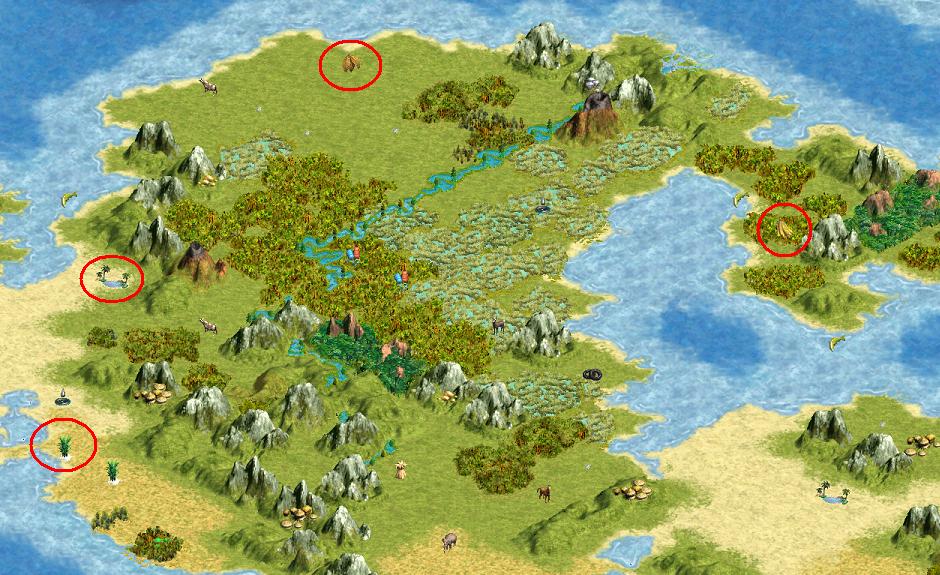
Marsh: One of the two new types of terrain, marsh is pretty similar to jungle in a lot of ways. It produces 1 food, no shields, no commerce, and cannot be mined or irrigated; the only way to improve the tile is to clear it using workers. Unlike jungle though, settlers cannot found cities on marsh tiles; the tile has to be cleared of marsh first and then settled. Marshes are impassable by wheeled units and it confers a minor defensive bonus (20%). I personally really dislike these tiles and wish that they had not been added; the only real effect of marsh tiles is to provide an irritation to settling efforts. In the picture above, the marsh tiles are east of the river and contain an oil resource.
Volcano: These tiles are very similar to mountains, except of course that they are liable to explode at random moments. Volcanos provide no food, no commerce, and three shields and cannot be mined or irrigated. They cost three movement points, just like mountains, and also cannot be settled upon. Their main selling point, of course, is their eruptions; volcanos will explode randomly and gush forth lava which destroys anything it touches. Cities which are hit by lava will be destroyed (razed) and wiped off the map! Sometimes there is a warning message that volcanos are about to erupt, sometimes not. I'm not a big fan of volcanos either and could do without their random effects. There are two volcanos in the picture above.
Sugar: One of the new bonus resources; all of the new resources are actually bonus resources, in fact. Sugar addes one food and one commerce to the tile it appears on; sugar only appears on plains and hills tiles. A sugar resource is circled in the bottom left corner of the picture above.
Tropical Fruit: The official name of this may be "tropical fruit", but everyone I know calls this by its real name: bananas. The yellow things add 1 food and 1 commerce to the tile they appear on, and not surprisingly this is always a jungle tile. Bananas appear in the jungle on the right side of the above picture.
Oasis: This resource adds two food and nothing else to the tile in which it appears. Unfortunately oases can only appear in desert tiles, so they are only of limited value in settling cities. Agricultural civs in particular though can get good use out of them. An oasis is circled on the left side of the picture.
Tobacco: An almost worthless bonus resource, this one adds one point of commerce and nothing else to the tile it occupies. It can appear on either grassland or hills tiles, and one is circled at the top of the above picture.
Citizen Specialists
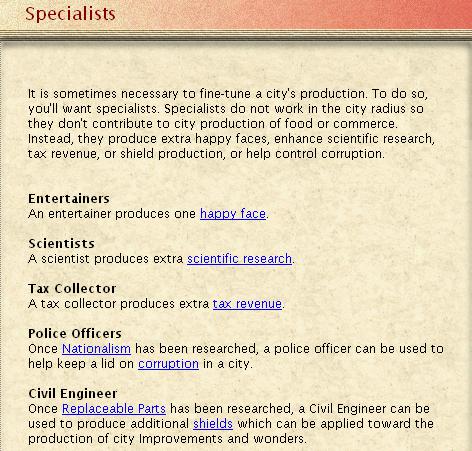
Police Officer: After discovering Nationalism you can build these guys, who reduce corruption in their city. The effect is pretty significant; cities which would otherwise be uselessly corrupt can frequently get a couple of shields and commerce back if enough of these are used. Along with civil engineers, they provide a good incentive to irrigate your completely corrupt cities to increase their population and make some of these specialists. A definite improvement to the game which adds more strategic depth.
Civil Engineers: Another specialist which was overdue. After researching Replaceable Parts, you can use thm to get some shields in your hopelessly corrupt cities. A size 30 city on the other side of the world from your capital can still get a decent production rate with these specialists providing shields. Another feature I very much like.
Others: Entertainers have been unchanged, but Tax Collectors now provide two gold instead of one and Scientists provide three beakers instead of one. These changes definitely take these specialists from the useless category into the potentially helpful.
Miscellaneous Changes
Difficulty Levels: Demigod and "Sid" form the two new difficulty levels, with the former being a bit easier than Deity and the latter a lot harder. The AI civs on Demigod get a 70% cost factor and start with a bonus settler, making that difficulty quite a bit tougher than Emperor but still easier than Deity. The Sid AI civs have a cost factor of 40%, start with 3 settlers, 5 workers, tons of free units, and have massive unit support and trading bonuses. I discussed these difficulties quite a bit in my testing reports, so I will not go into more detail here and refer the reader to those earlier sections.
Setup Screen: The initial setup screen has a couple new features; take a look:
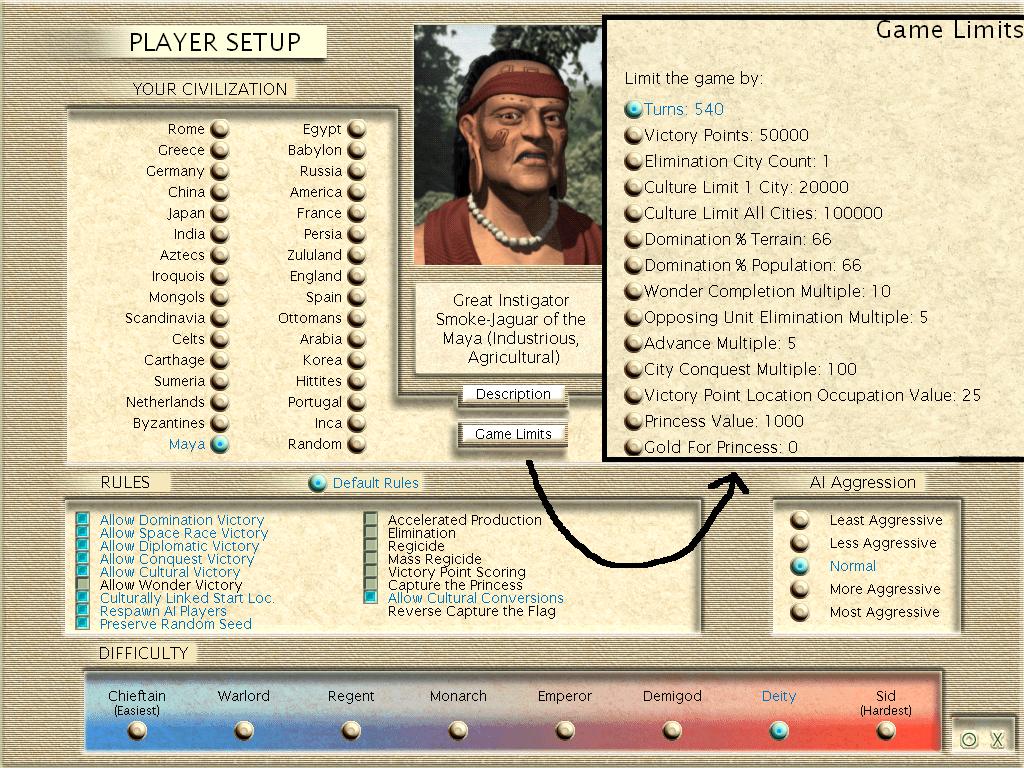
In addition to the new civs and difficulties, you can also now set the aggression level for the AI civs to your preference. The victory limits for the game are also all adjustable here without needing to go into the Editor to mess around. If you don't like the standard victory levels, changing them is as easy as typing in a new number. A big thumbs-up must go to BreakAway for adding these additional options to the player.
Victory Status Screen: The F8 status screen has also been upgraded to reveal a lot more information. The histogram score and cultural information is still there, but a new screen has been added with lots of interesting stuff. I think the picture is pretty self-explanatory, so I'll just post that and get out of the way.
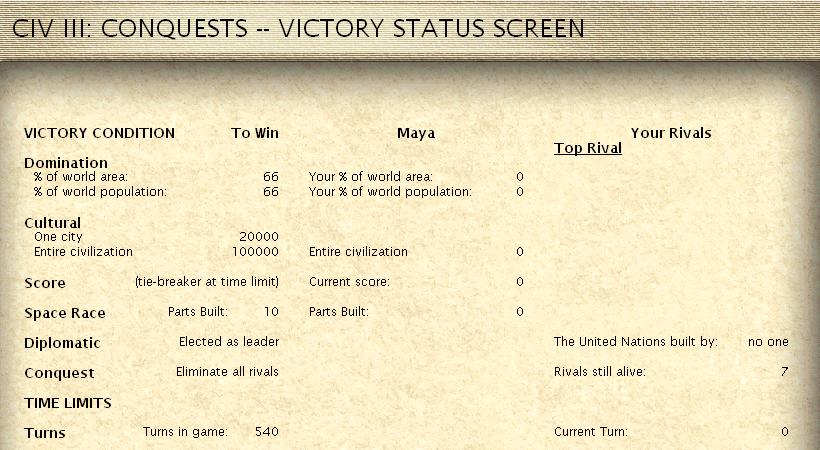
Barricades: These things are another new worker option. Essentially, they are super-fortresses, providing a 100% defensive bonus to any unit stationed inside and interdicting enemy movement. Paranoid people with lots of workers with nothing to do can build these things along their borders to stop enemy fast units from moving inside. Here's the Civilopedia entry, showing more information:
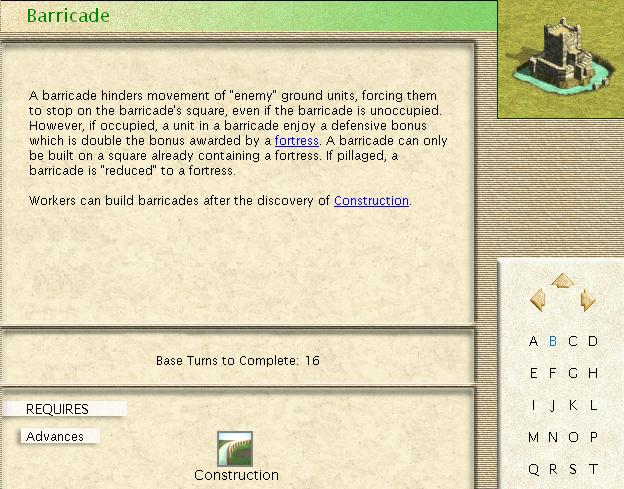
Info Blips
- Cruise Missiles can now be transported by ships.
- Workers can be airlifted (finally).
- Ships in port take double damage from bombardment. No turtling to avoid combat is possible.
- Air units can only be rebased up to three times their operational range away. No more rebasing to the other side of the planet.
- Conquering an enemy capital increase the chance for cultural flips to your civ (word of mouth only; have not verified this in person).
- Bombardment of tiles creates craters which must be cleaned up by workers.
- Upgrade cost now 3 gold/shield for all units. Rush-build was still 4 gold/shield in the last version of the beta, so I have seen no increase here, despite Internet rumors to the contrary. Could have been changed from the last beta version, of course.
- Min science now takes 50 turns instead of 40.
- Forest tiles take half the worker turns to chop down compared to before. I have no idea why, but that's the case.
- Barracks are now represented on the map with a little sword icon, just like harbors and airports.
There are probably more things I've missed, but that's all I can think of at the moment. Conquests clearly adds a lot of different things to the standard game, and greatly affects gameplay across the board. Now that the standard game has been covered in detail, the last section discusses the nine featured Conquest scenarios spanning the timeline of human history.






